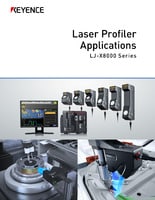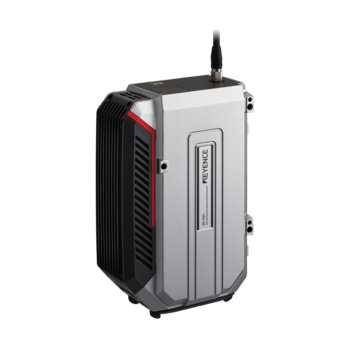Measurement Sensors
- 2D/3D Laser Profiler LJ-X8000 series
- High-speed 2D Laser Profiler LJ-V7000 series
- 2D Laser Displacement Sensor LJ-G5000 series
- Confocal Displacement Sensor CL-3000 series
- Ultra High-Speed/High-Accuracy Laser Displacement Sensor LK-G5000 series
- High-Speed, High-Accuracy CCD Laser Displacement Sensor LK-G3000 series
- Image-Based Laser Sensor IX series
- CMOS Multi-Function Analog Laser Sensor IL series
- Telecentric Measurement System TM-X5000 series
- High-speed optical micrometer LS-9000 series
- High-speed 2D Optical Micrometer TM-3000 series
- High-speed, High-accuracy Digital Micrometer LS-7000 series
- Multi-Purpose CCD Laser Micrometer IG series
- Thrubeam Type Laser Detection Sensor IB series
- 3D Interference Measurement Sensor WI-5000 series
- Micro-head Spectral-interference Laser Displacement Meter SI-F series
- Spectral-Interference Wafer Thickness Meter SI-F80R series
- High-speed, High-Accuracy Digital Displacement Inductive Sensor EX-V series
- Inductive Gauging Sensor AS series
- High-accuracy Positioning Sensor EG series
- High-Accuracy Digital Contact Sensor GT2 series
- General Purpose Digital Contact Sensor GT series
Dimension Measurement
Displacement Measurement
- Measurement Sensors for the Medical and Pharmaceutical Industry
- Measurement Sensors for the Fiber Optic/Cable Industry
- Measurement Sensors for the Film and Sheet Industry
- Measurement Sensors for the Electric Vehicle Industry
- Measurement Sensors for the Semiconductor Industry
- Measurement Sensors for the Electronics Systems Industry
- Measurement Sensors for the Food and Beverage Industry
- Measurement Sensors for the Automotive Manufacturing Industry
- Measurement Sensors for the Metal and Steel Industry
3D Profile Measurement
3D profile measurement systems have become increasingly popular due to their ability to scan a surface in all three dimensions and provide detailed information about the surface topology of scanned objects. These measurement systems became invaluable across various industries for a range of applications, including product quality control in manufacturing, dental and medical imaging, and many other industries.
However, when looking for the best way to perform profile (3D) measurement, there are several important factors to consider, including the type of measurement system and the installation environment. Selecting equipment that doesn't adequately meet your needs can lead to insufficient precision and increased man-hours during production. This site is designed to help users determine the best way to perform measurements with confidence regarding a 3D shape measurement system.
How to Measure 3D Shapes
Accurately capturing and presenting 3D profiles requires a selection of adequate measurement methods and equipment. You should begin by clearly defining your specific need and application—such as measurement area’s size, required resolution, and scanning speed. After that, you should familiarize yourself with the optimal measuring systems available. Don’t hesitate to seek industry expert advice, as it can often provide valuable insight. Find the best measurement method and the right equipment to measure "3D Shapes".
The Measurement Location is 10 × 10 mm or Smaller

Measuring the height of balls on a BGA
Precision is crucial when it comes to small measurements, and in this case, high-resolution interferometry imaging techniques could be employed, as they would allow capturing the surface area down to all the minute details. Laser scanning confocal scanners are applicable for fine-scale applications, such as measuring the height of balls on a BGA. The optimal measurement system for this application is a reflective 3D laser displacement device, as it captures 80,000 points of height data.

Optimal Measurement System Reflective 3D Laser Displacement Sensor
The WI-5000 Series captures 80,000 points of height data instantaneously across a maximum measurement area of 10 × 10 mm.
The principles of white light interferometry result in highly accurate micron-level measurements with no influence from the material, color, or blind spots.

-
1Peak height
-
2Flatness
-
3Height difference
Even if the target is at an angle, automatic correction allows the surface shape to be captured accurately.
This makes highly accurate micron-level measurements possible.

3D Interference Measurement Sensor WI-5000 Series
3D surface measurements in just .13 seconds.
Click here for more details
The Measurement Location is Larger than 10 × 10 mm (In-line Measurement)

Profile measurement of connecting rods
Speed and efficiency of the measurement process become increasingly important when dealing with in-line measurements for areas larger than 10×10 mm, as these measurements are usually done during the manufacturing process. Laser triangulation and structured light scanning are the two most commonly used 3D scanning techniques used during in-line measurements, as they can rapidly capture the object’s 3D profile while the object moves along a production line. The optimal measurement system associated with this application lies in 2D Triangulation Laser Displacement.
Optimal Measurement System 2D Triangulation Laser Displacement Sensor
A 3D shape can be constructed by acquiring and overlaying multiple cross-sectional shapes from locations where the laser line hits. In-line measurement of the entire shape is achieved with the fastest sampling speed in the world.

-
1Cross-section
-
23D shape

2D/3D Laser Profiler LJ-X8000 Series
LJ-X laser profilers collect height data across a laser line rather than a single point. This enables 2D/3D measurements such as height difference, width, or angle to be performed using a single sensor.
Click here for more details
- 2D triangulation method
- In-line multi-point measurement
- World's fastest sampling rate at 64,000 images/sec

Confocal Displacement Sensor CL-3000 Series
High-precision measurement on all targets, with simple sensor head installation and program settings. CL-3000 Series ultra-compact coaxial laser displacement sensors address manufacturing challenges such as improving quality, preventing the shipment of defective parts and increasing production.
Click here for more details
- Multi-color confocal method
- Linearity:From ±0.2 µm
- Confocal displacement sensor
The Measurement Location is Larger than 10 × 10 mm (Offline measurement)

Profile measurement of solder
Offline measurements refer to those measurements that are taken off the production line. This approach ensures more time and flexibility, allowing for a more time-intensive and, thus, a more precise approach to scanning the surface of the object. The optimal measurement system associated with this profile is Triangulation Laser Displacement +X-Y Stage technology.

Optimal Measurement System Triangulation Laser Displacement Sensor + X-Y Stage
High-precision 3D shape measurement is possible by combining a 1D laser displacement sensor with an X-Y stage.
- Selective use of sensor heads enables shapes of various heights to be measured.
- The shape of transparent 3D targets can also be measured.

Confocal Displacement Sensor CL-3000 Series
High-precision measurement on all targets, with simple sensor head installation and program settings. CL-3000 Series ultra-compact coaxial laser displacement sensors address manufacturing challenges such as improving quality, preventing the shipment of defective parts and increasing production.
Click here for more details
- Multi-color confocal method
- Linearity:From ±0.2 µm
- Confocal displacement sensor

Micro-head Spectral-interference Laser Displacement Meter SI-F Series
Introducing the world’s first micro-head, with the highest measurement accuracy in its class and a level of performance that was previously thought impossible. These micro-head sensors can be used to measure the thickness and warpage of high-precision objects such as silicon wafers.
Click here for more details
- Spectral interference method
- Ultra-high resolution of 1 nm
- 2 mm microprocessor sensor head
How can 3D Images Be Created from 2D Measurements?
3D laser displacement sensors record 3D data as a series of 2D scans and then use software to analyze the collected data and present it as a whole, coherent 3D profile of a certain object. This software does more than simple scanning; it generates detailed reports that provide measurements and identifies potential issues and anomalies that can occur. This is why 3D profile management is important. It centers on data collection, stores it, and sets various benchmarks based on performance—this includes collaborations or maintenance as well.
What is Needed to Measure 3D Profiles and Shapes?
Measuring 3D profiles is rather simple with a laser profiler. However, either the object or the laser profiler must be moving to scan the necessary surfaces and capture data. Once the data is captured, the sensor will rely on software to process, analyze, and visualize the 3D profile. You also need trained personnel. Although using 3D scanners is a rather user-friendly experience, having properly trained personnel who can both use the equipment and interpret the data collected is essential to accurately measure 3D profiles and shapes.
Related Downloads
![Key Technology and Applications [3D Measurement]](/img/asset/AS_110781_L.jpg)
This guide compiles examples of 3D measurement applications using the LJ-X8000 Series 2D/3D laser profilers. Benefits in various inspection processes and items are explained concisely with graphics.

This guide offers many examples of 2D and 3D profile measurements and inspections using laser profilers. The high-definition imaging of the LJ-X8000 Series at 3200 points per profile enables reliable detection of even the slightest defects.
Related Products
Applications
Dimension Measurement
Displacement Measurement
Profile Measurement
Industries
- Measurement Sensors for the Medical and Pharmaceutical Industry
- Measurement Sensors for the Fiber Optic/Cable Industry
- Measurement Sensors for the Film and Sheet Industry
- Measurement Sensors for the Electric Vehicle Industry
- Measurement Sensors for the Semiconductor Industry
- Measurement Sensors for the Electronics Systems Industry
- Measurement Sensors for the Food and Beverage Industry
- Measurement Sensors for the Automotive Manufacturing Industry
- Measurement Sensors for the Metal and Steel Industry


